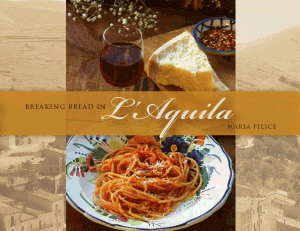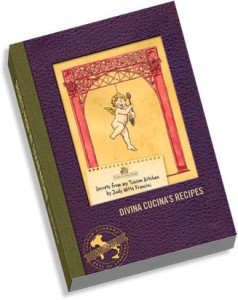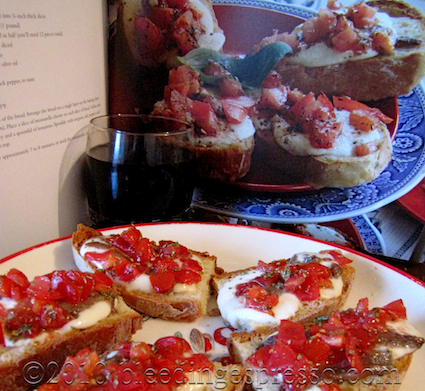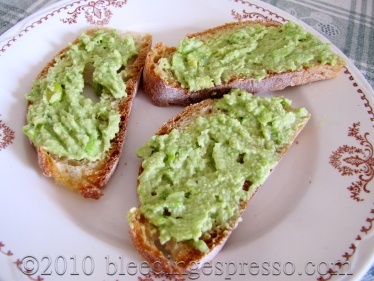Archive for the ‘what’s cooking wednesday’ Category
Best Crostini Recipe Ever + Breaking Bread in L’Aquila
 Maria Filice‘s Breaking Bread in L’Aquila is a product of love — love for her late husband Paul Piccone, of his native city L’Aquila in Abruzzo (yes, the same one that was devastated by an earthquake last year), of her own Calabrian heritage (Marie’s parents were born in Cosenza), and of delicious, simply prepared Italian food.
Maria Filice‘s Breaking Bread in L’Aquila is a product of love — love for her late husband Paul Piccone, of his native city L’Aquila in Abruzzo (yes, the same one that was devastated by an earthquake last year), of her own Calabrian heritage (Marie’s parents were born in Cosenza), and of delicious, simply prepared Italian food.
Marie graciously shares this amore with us, and indeed, is donating net proceeds of the book to the continuing relief efforts in Abruzzo and is also appearing in Santo Stefano di Sessanio, Abruzzo this Saturday, May 15, if you’re in the neighborhood!
The layout of this hardcover book is gorgeous with the recipes on the left side and full-color photos on the right — for each and every recipe. And the organization is unique as well: recipes are divided into menus that include antipasti (appetizers), primi piatti (usually pasta), secondi piatti (meat), contorni (vegetables), and dolci (desserts) for each day of the week; if you have a special dinner coming up, you can just open up Maria’s book and have a menu all set. Perfetto!
Many of Maria’s 50 or so recipes are classics like aglio olio peperoncino and bruschetta, but there are also some that were new to both Paolo and me. On my first run through, I made a note of at least five different recipes to try immediately with things we already had in the house.
In case you don’t realize, that’s pretty darn impressive for a southern Italian cookbook in a southern Italian house.
Speaking of items we had on hand, Maria also includes the “Pantry Page” with a checklist of things you should always keep handy. That stocked pantry is one of the most important parts of true Italian cooking, i.e., deciding what’s for dinner based on what you have on hand, and even better, having it on the table within about an hour. *That* is an Italian art form, and Maria has captured its essence wonderfully.
Breaking Bread in L’Aquila would be an excellent addition to any cookbook collection as it is not only full of great recipes, it’s simply a gorgeous book. Even if you don’t cook, you’ll enjoy the photos! And if you need a gift, particularly for someone with an interest in Italian and/or southern Italian cuisine, this is perfect.
I give this cookbook five extremely full espresso cups out of five; I couldn’t recommend it more.
**THIS CONTEST IS OVER**
Maria is offering up a copy of Breaking Bread in L’Aquila to one lucky Bleeding Espresso reader. Just comment on this post by May 20, 2010 at 11:59 p.m. (CET) to enter.
Now, without further ado, Maria’s recipe for Crostini with my slight adaptations; I am not exaggerating when I say I’ve made these at least once a week since I received Maria’s book (on Paolo’s specific request). We’ve had them as afternoon snacks and as dinner. They are so, so, so good — especially with a nice glass of red wine.
Crostini from Breaking Bread in L’Aquila by Maria Filice
(as adapted by me)
(serves 2)
- 6 slices of Italian bread, about 1/4 inch thick
- 2 small to medium-sized balls of fresh mozzarella, sliced
- 6 anchovy fillets
- 2 medium tomatoes, diced
- Handful of capers
- 1 tablespoon olive oil
- Oregano and salt to taste
1. Preheat oven to 375°F (190°C).
2. In a small bowl, mix together tomatoes, olive oil, oregano, and salt. Let stand while you arrange the rest.
3. Arrange slices of bread in a single layer on a baking sheet.
4. Place a slice or two of mozzarella on the bread so that you cover most of it.
5. Put an anchovy fillet on each slice of bread (more if you like anchovies like we do!).
6. Add some capers to each slice (I put three or four on each slice — we like capers too).
7. Cover the slices with the tomato mixture. I’ve found a fork actually works better than a spoon for this; you don’t want a whole lot of liquid making it onto the crostini as it’ll make the bread soggy.
8. Sprinkle with more oregano.
9. Bake in the oven for about 7 or 8 minutes, or until cheese melts.
10. Serve immediately, preferably with a glass of red wine.
Buon appetito!
What’s Cooking Wednesday: Fava Bean Spread
When we get fava beans, we tend to get them by the kilo…several kilos.
We usually just eat them either raw or cooked with Calabrian sausage, but this year I was determined to do something different. Somehow I got the idea in my head to make a fava-based hummus. I love chickpea-based hummus, which I make here despite the lack of tahini, so I gave it a go.
I really enjoyed it, so I’m posting the recipe in case you’d like to try it too.
Some notes before beginning:
- The measurements in this recipe are estimates (although I am usually pretty good at estimating, so do feel safe in using them as general guidelines). Even if I did measure things exactly, though, amounts are going to differ by personal choice, so use your judgment. I trust you!
- This recipe makes enough fava spread for about five slices of bread, the size of which you can see in the photo (each slice sits comfortably in my hand with outstretched fingers). For two people as an appetizer or snack this is a great amount; the mixture probably isn’t going to keep very long in your fridge, so I don’t know how much leftover you really want to make.
- The spread might be even better after sitting for just a little while to let the flavors merge, but I wouldn’t say to leave it more than a day or two. When I make hummus and put it in the fridge, it’s not very appetizing after just two days.
- After I made this, I then looked online for similar recipes. I know. Cart before the horse and all. I see that many blanch their favas before making a spread with it. If you want to do that just give them a dip in boiling water for about 30 seconds and then proceed with the mashing. I think this may be mainly to get the external shell off and make digestion easier, but you can just remove it yourself while they’re raw and keep all the nutrients intact to boot. That’s my recommendation, unless you have particularly hard favas that you think won’t mash well. Judgment time again!
- I added the peanut butter to this recipe because I thought it still needed *something*; if you have tahini, you can certainly try that. You can also try it without the peanut butter or tahini, of course.
- If you play around with this recipe, please let me know. I think it’s a great base spread that can go many different ways, and I’d love to hear your suggestions! This would also be great with some other stuff layered on top or bottom from sardines to ricotta cheese to diced tomatoes. Mmmm.
Fava Bean Spread
- Fresh shelled favas from about 20 medium to large pods
- 1 small clove of garlic, minced
- 3 tablespoons olive oil (just enough to give it some moisture, not make it oily)
- 2 teaspoons peanut butter
- 3 squeezes of lemon juice
- Salt to taste
1. Puree together all ingredients to your desired level of smoothness; I like mine a little chunky.
2. Taste for what’s off/missing and adjust.
3. Spread on toast, fresh bread, crackers, grilled meats, raw veggies, whatever you like!
Buon appetito!
Peas with Pancetta Plus Divina Cucina’s Secrets from a Tuscan Kitchen Cookbook
 My friend Judy Witts Francini kindly sent me a copy of her handcrafted cookbook, Secrets from My Tuscan Kitchen, and has even more kindly offered to give a lucky Bleeding Espresso reader a chance to win a copy as well.
My friend Judy Witts Francini kindly sent me a copy of her handcrafted cookbook, Secrets from My Tuscan Kitchen, and has even more kindly offered to give a lucky Bleeding Espresso reader a chance to win a copy as well.
To enter the random drawing, all you need to do is comment on this post by 11:59 pm (CET) on Tuesday, March 30, 2010.
Trust me, you’re going to love this cookbook. Not only is it absolutely full of tasty recipes from appetizers to desserts, Judy’s cookbook is also aesthetically pleasing and a cook’s best friend with each page facing the recipes blank so you can add your own notes.
If you don’t know, Italian cooking is very regional, i.e., what you’ll find in Calabria, you probably won’t find in Piemonte, and vice versa. So for those of you who want to get a great taste of what eating in Tuscany is like, you must see Judy’s cookbook, which is based on her own experiences of living in the region for nearly 30 years, particularly as influenced by her Tuscan mother-in-law.
You can read more about Judy’s cookbook and how you can order your own at Judy’s website, Divina Cucina. You can also keep up with Judy at her blog Over a Tuscan Stove and on Twitter @divinacucina.
Of course I wanted to share a recipe with you as I shared Judy’s book this What’s Cooking Wednesday, so I chose something I knew that would be a big hit here. Judy has two recipes for peas in the book, one with pancetta (Piselli alla Fiorentina) and the other with cooked ham (Piselli al Prosciutto); I actually ended up combining the two recipes to adjust for what I had handy (ran out of garlic!), but what I made was closer to Piselli alla Fiorentina, so here you go.
Ah, also, I did leave out the sugar, as P freaks out when he tastes sugar. The peas were definitely sweet enough, and this dish was delicious…and talk about easy peasy! Sorry, couldn’t resist.
Piselli alla Fiorentina
- 1 lb peas
- 2 oz pancetta, cubed
- 1 clove garlic, sliced
- 2 tbs chopped parsley
- 1 tbs sugar
- Salt
- 8 tbs olive oil
1. Place peas, garlic, parsley and olive oil in a saucepan. Add salt to taste.
2. Add enough water to cover peas.
3. Cook over low heat, covered.
4. Just before the peas are done, add the pancetta and sugar. Serve with their sauce.
Buon appetito!
Remember to comment for your chance to a win a copy of Judy’s cookbook!
Borlotti Beans: Facts and Recipes
Borlotti beans are one of the staples of our diet in my house in Calabria, so it’s about time we talked more about them, don’t you think?
Borlotti beans are also known as cranberry beans or French horticultural beans and are some of the cutest darn beans around if you ask me.
Don’t get too excited about how festive they look, though, as that color goes away with cooking. They eventually turn brown.
What do they taste like? I’m not a bean expert or anything, but to me, borlotti beans taste most like what those of us who enjoy baked beans are used to having. They’re meatier than your average white cannellini bean, aren’t at all sweet, and hold up *extremely* well with tomatoes in particular. I speak from experience (we’ll get to that in a minute).
Here you can find borlotti in all kinds of ways–dried, fresh, jarred, canned. If you get the dried version, you’re going to have to soak them overnight before using them.
And they’re good for you! They’re high in protein (23.03g in 100g dried) and fiber (24.7 g). See more nutritional information at (where else?!) Borlotti.com.
So now I’m sure you’re wondering what to do with these loverlies. Well, they’re great in just about any type of dish from soups and stews to cold salads, so I do encourage you to use your imagination.
For some guidance, though, I posted a recipe a very long time ago, my very first recipe ever posted in fact, so you may have missed it:
Borlotti Beans with Tomatoes, Garlic, and Basil
We eat this literally once a week here throughout the winter, so it comes *highly* recommended.
For some other ideas on what to do with borlotti, check out what some of my blog friends have shared:
- Barbecue Baked Beans with Bacon at Sara’s Ms Adventures in Italy
- Braised Borlotti Beans with Red Peppers, Parsley, and Berbere Spice at Ilva’s Lucullian Delights
- Cowboy Beans with Smoked Sausage at Jenn’s The Leftover Queen
- Cranberry Beans, Kale, and Sausage Stew at The Passionate Palate
- Minestrone with Fresh Borlotti Beans and Farro at Susan’s Porcini Chronicles
What is your favorite bean dish, borlotti or not?
Banana Nutella Brownies: Buon World Nutella Day 2010!
Since my frozen overripe banana collection is getting a bit out of hand, I decided to play with a brownie recipe for World Nutella Day: a banana-chocolate chip brownie recipe to be exact.
Read on...





















